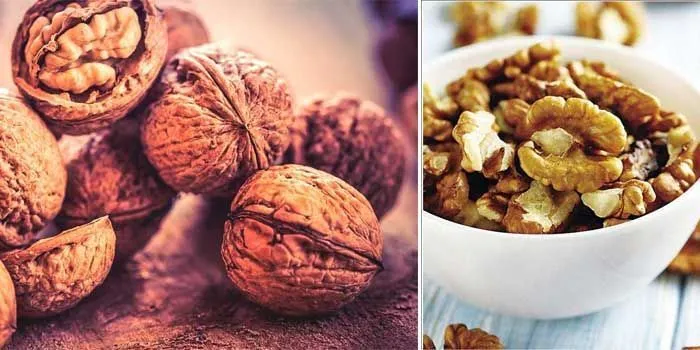Nuts are a very nutritious food with a great balance in its nutritional composition. It is widely introduced into the Mediterranean diet and its moderate consumption is beneficial for health.
The properties of walnuts and other nuts allow us to stimulate appetite, reduce fat intake and offer us a wide range of antioxidants that improve our overall health.
However, and as it happens in all types of foods, we must know the recommended dose and not go beyond it, since they contain a high caloric value.
Table of Contents
Nutritional value and properties of nuts
The high concentration of unsaturated fatty acids, proteins, fiber and mineral elements contribute to defining the properties of nuts.
In general, Health Agencies establishes a recommended daily amount of 20 to 30 grams per day within the group of nuts. Therefore, let’s see what that daily ration brings us to the body.

A serving of 30 grams contains:
- Energy: 173 kcal
- Proteins: 5 grams
- Fats: 16 grams, including 9 grams of monounsaturated fat
- Carbohydrates: 6 grams
- Fibre: 3 grams
Other elements included in the properties of walnuts
- Vitamin E: 12% of the recommended daily allowance.
- Magnesium: 16% of the recommended daily allowance.
- Phosphorus: 13% of the recommended daily allowance.
- Copper: 23% of the recommended daily amount.
- Manganese: 26% of the recommended daily allowance.
- Selenium: 56% of the recommended daily allowance.
Benefits and properties of nuts
Antioxidant properties of walnut
One of the main incentives of its consumption are the properties of nuts to provide antioxidant compounds.
Among them, there are various polyphenols that help us fight oxidative stress and reduce free radicals that cause cell damage.
There are several scientific studies that have concluded the benefits of nuts with a daily consumption of 25 to 30 grams [Study 1] [Study 2].
These benefits, however, are not as conclusive in sick or elderly people, where antioxidant markers did not show great changes with moderate consumption of nuts.
Contribute to body weight control
The balanced diet allows us to control body weight based on eating, of great variety, small amount.
The fact of being able to take nuts, for example, as an appetizer before meals, allows us to increase satiating power and reduce the intake of carbohydrates and subsequent saturated fats.
Therefore, the effect to control weight is not direct nor is it associated with the consumption of nuts and their activity in the digestive system. However, yes indirectly by allowing to reduce, based on being more satiated, the consumption of less healthy foods.
There are even scientific trials where they address that the fats of nuts and other nuts are not necessarily found in the fruits but stuck to the shell on the inside, so the total calorie level is significantly lower.
Allows to control bad cholesterol

Consumption of unsaturated fatty acids such as Omega 3 (also present in avocado) or others is an aid to improve the cardiac response and reduce the level of triglycerides in the body.
As for the properties of walnuts to control bad cholesterol, there are several studies that have linked a remarkable drop in cholesterol levels after the periodic intake of 25 to 30 grams of nuts daily. [Study]
This has shown an important effect in controlling LDL cholesterol levels and triglycerides. Similarly, it also happens with other nuts such as pistachios and almonds.
New studies have tried to link the decline in triglyceride levels in a framework of obese population, obtaining a reduction of dichlevels above 30% in 12 weeks (3 months). [Study]
The explanation of the effect of the properties of walnuts are due to their content in monounsaturated and polyunsaturated fatty acids, which act with a positive response for the body, balancing and reducing the levels of LDL cholesterol against the elevation of the considered as good (HDL).
Properties of anti-inflammatory nuts
The anti-inflammatory potential of a product is its ability to reduce the consequence of injuries from muscle damage, action of bacteria or pathogens that are harmful to the body.
Moreover, there is chronic inflammation of tissues that causes organ damage and increases the risk of disease. Therefore, this is where research is focused, trying to answer the question of whether the properties of walnuts have anti-inflammatory potential.
Several scientific investigations have been developed where credibility is given to the anti-inflammatory action of the properties of nuts. [Study].
This can have an impact on reducing the risk of contracting diseases and reducing cellular aging.
The properties of walnuts they can also be applied to other nuts, such as Brazil nuts, almonds and pistachios, where clinical trials have shown similar levels of efficacy.
Benefits those suffering from diabetes
The type 2 diabetes it is an increasingly common type of disease that affects hundreds of millions of people around the world, especially in the Western world.
Metabolic syndrome is linked to a group of risk factors that can increase the risk of heart disease, diabetes or stroke.
Therefore, metabolic syndrome and type 2 diabetes are closely linked and linked.
In fact, the nuts they are one of the most interesting foods for those people who suffer from metabolic syndrome along with type 2 diabetes.
Nuts are low in carbohydrates and do not excessively increase blood sugar levels (low glycemic index). Therefore, we can increase the consumption of nuts and reduce those foods that have a high concentration of carbohydrates to reduce the level of sugar in the blood.
Scientific studies link regular nut consumption to reduced oxidative stress, as well as lower blood pressure and other markers in people suffering from diabetes and metabolic syndrome [Walnuts and oxidative stress]
High fiber content
The daily intake of 30 grams of nuts gives us about 3 grams of fiber. It has been scientifically proven that maintaining a high fiber intake causes health benefits, both at the digestive level and at the cardiorespiratory level.
Among the benefits of high fiber intake are a significant improvement in intestinal health, reducing obesity and combating diabetes. [Study]
Fiber content of the main nuts on the market.
Fiber concentration for 30 grams recommended daily.
- Almonds: 3.5 grams
- Pistachios: 2.9 grams
- Hazelnuts: 2.9 grams
- Pecans: 2.9 grams
- Peanuts: 2.6 grams
- Macadamias: 2.4 grams
- Brazil nuts: 2.1 grams
The properties of walnuts in heart health
The contribution of unsaturated fatty acids, minerals and vitamins benefits the health of the circulatory system.
A significant effect has been studied in reducing blood pressure, LDL cholesterol and triglyceride levels and, therefore, a benefit against the likelihood of stroke or heart disease. [Study] [Study]
How many nuts can I take a day?
It is considered appropriate to consume a daily serving of nuts with an amount of 30 g. This, in walnuts, is equivalent to 3 or 4 a day, the amount of which will have to be reduced if we also introduce other nuts such as almonds or pistachios, for example.
It is advisable to acquire those nuts that have low salt content and do not have additives. In fact, in the case of almonds, it is advisable to take them even with skin, since they are a source of fiber.
